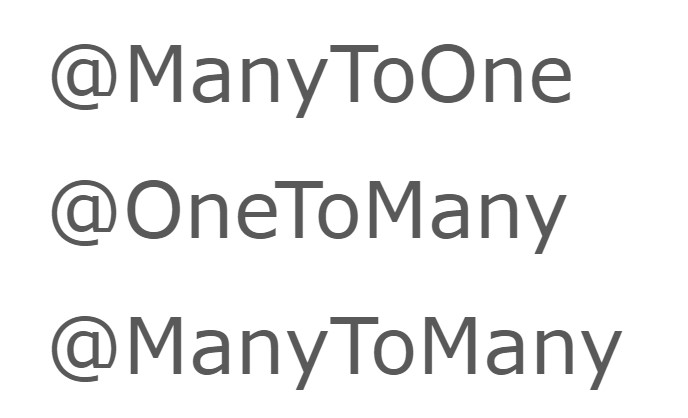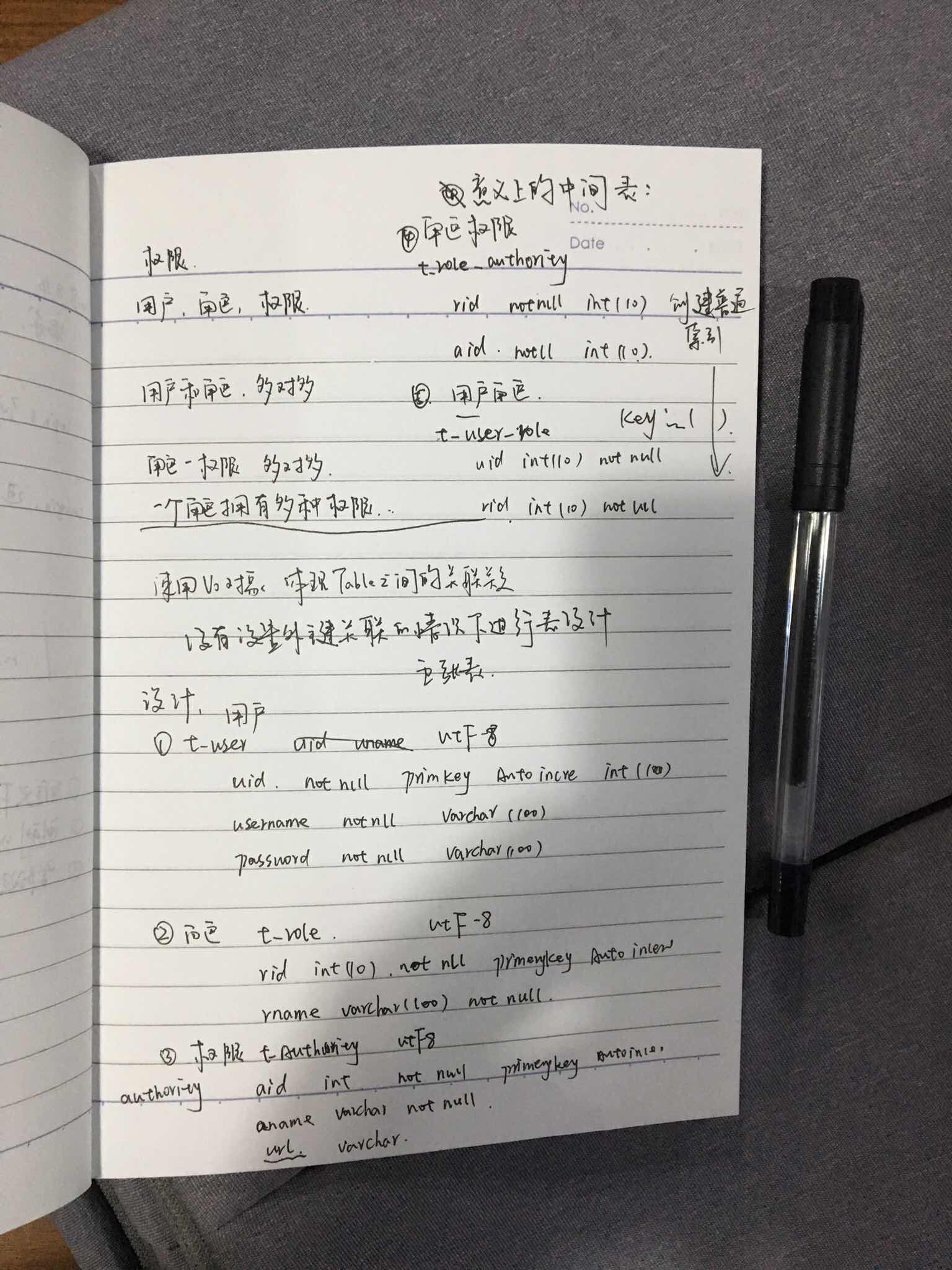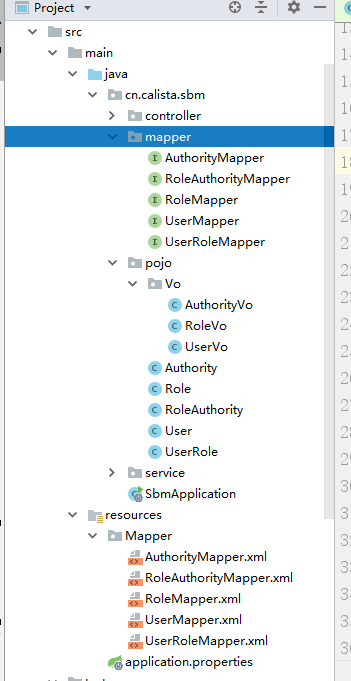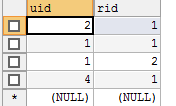相信有很多同学都有使用过Hibernate框架的开发经验,尽管现在开发人员对Hibernate的褒贬不一,我们暂且不谈这个话题。
图中的三个注解,正好解析了表与表之间的关联关系。我也就不这这方面进行过多的赘述了。所以...
今天的主题是:我想在不涉及表与表之间的关联关系的情况下对表进行关联。
换成对应的表的意思就是,不设外键,实现多对多关联。话不多说 先上一张我自己的设计手稿:
数据库:(数据库的编码(utf8)与数据库引擎(InnonDB)已经设置好了)
CREATE table t_user(
uid int(10) NOT NULL PRIMARY KEY AUTO_INCREMENT,
username VARCHAR(100) not null,
password VARCHAR(100) not null,
createtime date not null
)default CHARSET=utf8;
-- 创建角色表
CREATE TABLE t_role(
rid int(10) not null PRIMARY KEY AUTO_INCREMENT,
rname VARCHAR(100) not null
)
-- 权限表db_auth
CREATE TABLE t_authority(
aid int(10) not null PRIMARY KEY AUTO_INCREMENT,
aname VARCHAR(100) not NULL,
url VARCHAR(100) not NULL
)
-- 意义上的中间表
CREATE TABLE t_role_authority(
rid int(10) not null,
aid int(10) not NULL,
KEY index_rid(rid),
KEY index_aid(aid)
)
CREATE TABLE t_user_role(
uid int(10) not null,
rid int(10) not null,
KEY index_uid(uid),
KEY index_rid(rid)
)
项目框架选型我用的是SpringBoot+MyBatis
Vo类:
package cn.calista.sbm.pojo.Vo;
import cn.calista.sbm.pojo.Authority;
import java.util.HashSet;
/**
* 权限和角色也是多对多
*/
public class AuthorityVo extends Authority {
private HashSet<RoleVo> roleVos = new HashSet<>();
public HashSet<RoleVo> getRoleVos() {
return roleVos;
}
public void setRoleVos(HashSet<RoleVo> roleVos) {
this.roleVos = roleVos;
}
}
package cn.calista.sbm.pojo.Vo;
import cn.calista.sbm.pojo.Role;
import java.util.HashSet;
/**
* Role 和 User 多对对
* Role 和 authority 多对多
*/
public class RoleVo extends Role {
private HashSet<AuthorityVo> authorityVos = new HashSet<>();
private HashSet<UserVo> userVos = new HashSet<>();
public HashSet<AuthorityVo> getAuthorityVos() {
return authorityVos;
}
public void setAuthorityVos(HashSet<AuthorityVo> authorityVos) {
this.authorityVos = authorityVos;
}
public HashSet<UserVo> getUserVos() {
return userVos;
}
public void setUserVos(HashSet<UserVo> userVos) {
this.userVos = userVos;
}
}
package cn.calista.sbm.pojo.Vo;
import cn.calista.sbm.pojo.User;
import java.util.HashSet;
/**
* 用户和角色 多对多
*/
public class UserVo extends User {
private HashSet<RoleVo> roleVos = new HashSet<>();
public HashSet<RoleVo> getRoleVos() {
return roleVos;
}
public void setRoleVos(HashSet<RoleVo> roleVos) {
this.roleVos = roleVos;
}
}
这里说一句,虽然用户和角色是多对多的关系,但是我们在实际开发中并不会去关注一个角色被多少用户所拥有,我们关心的更多的是一个用户拥有哪些角色然后拥有多少权限。所以我们实际理解就可以理解为 用户和角色是 一对多的关系就OK
至于XML Mapper 的代码我就不在粘了 直接上核心代码
package cn.calista.sbm;
import cn.calista.sbm.mapper.*;
import cn.calista.sbm.pojo.*;
import cn.calista.sbm.pojo.Vo.AuthorityVo;
import cn.calista.sbm.pojo.Vo.RoleVo;
import cn.calista.sbm.pojo.Vo.UserVo;
import org.junit.Test;
import org.junit.runner.RunWith;
import org.springframework.beans.BeanUtils;
import org.springframework.beans.factory.annotation.Autowired;
import org.springframework.boot.test.context.SpringBootTest;
import org.springframework.test.context.junit4.SpringRunner;
import java.util.HashSet;
import java.util.Iterator;
import java.util.List;
@RunWith(SpringRunner.class)
@SpringBootTest
public class SbmApplicationTests {
@Autowired
private UserMapper userMapper;
@Autowired
private UserRoleMapper userRoleMapper;
@Autowired
private RoleMapper roleMapper;
@Autowired
private RoleAuthorityMapper roleAuthorityMapper;
@Autowired
private AuthorityMapper authorityMapper;
@Test
public void testMethod() {
UserVo userVo = new UserVo();
RoleVo roleVo = null;
AuthorityVo authorityVo = null;
//根据uid 查询到 user
User user = userMapper.getUser(1);
//拿到User 装配给 UserVo
BeanUtils.copyProperties(user, userVo);
//根据user的uid 查询 user_role 用户角色表 得到该 user所拥有的角色集合
List<UserRole> userRoleList = userRoleMapper.getUserRoleList(user.getUid());
//遍历 操作每一个 用户角色对象
for (UserRole userRole : userRoleList
) { // 拿到角色
Role role = roleMapper.getRoleById(userRole.getRid());
roleVo = new RoleVo();
// 拿到role 装配给 roleVo
BeanUtils.copyProperties(role, roleVo);
//通过每一个role的rid 查询中间表roleAuthority 的到该角色的权限集合
List<RoleAuthority> roleAuthorites = roleAuthorityMapper.getRoleAuthorites(role.getRid());
//遍历权限集合
for (RoleAuthority roleAuthority : roleAuthorites
) {
//通过aid查询到权限
Integer aid = roleAuthority.getAid();
Authority authority = authorityMapper.getAuthorityById(aid);
authorityVo = new AuthorityVo();
BeanUtils.copyProperties(authority, authorityVo);
authorityVo.getRoleVos().add(roleVo);
//装配roleVo中的AuthorityVos
roleVo.getAuthorityVos().add(authorityVo);
}
//装配userVo属性roleVos
userVo.getRoleVos().add(roleVo);
}
}
}
最后测试一下:
我想知道id是 1 的用户拥有哪些权限?
HashSet<AuthorityVo> authorityVos = roleVo.getAuthorityVos();
Iterator<AuthorityVo> it = authorityVos.iterator();
while (it.hasNext()){
AuthorityVo next = it.next();
System.out.println(next.getAname());
}
再查看一下数据库
最后,实现了关联。(并没有使用连接查询)



















